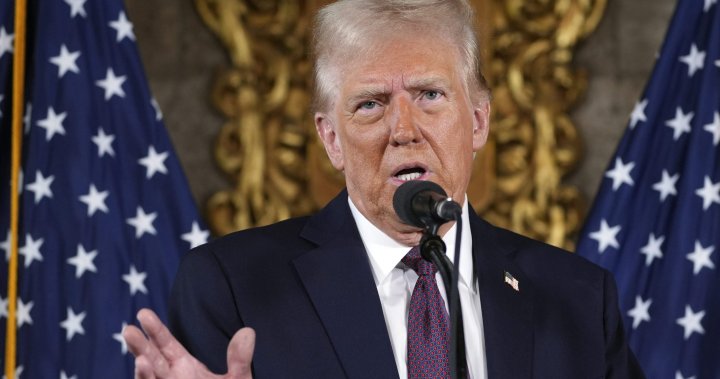Paragraph 1: Trump’s Renewed Calls for U.S.-Canada Merger and Trudeau’s Vehement Rejection
Former U.S. President Donald Trump reignited his unconventional proposal for Canada to become a U.S. state, asserting that such a merger could be achieved through "economic force." This statement, made during a press conference at his Mar-a-Lago resort, marked yet another instance of Trump’s repeated calls for absorbing Canada into the United States. Canadian Prime Minister Justin Trudeau, on the cusp of his resignation announcement, responded with his most forceful rejection to date, declaring that there was "a snowball’s chance in hell" of Canada joining the U.S. This exchange underscores the persistent tension between the two North American neighbors under Trump’s presidency and reflects his broader "America First" approach to international relations.
Paragraph 2: Trump’s Justification for Annexation and Trudeau’s Emphasis on Mutual Benefits
Trump’s rationale for annexing Canada centered on his perceived economic and security advantages for the U.S. He argued that the U.S. didn’t "need anything" from Canada in terms of trade, dismissing the significance of Canadian imports such as cars, lumber, and dairy products. He also reiterated his claim that the U.S. "subsidizes" Canada through trade and defense spending, specifically pointing to the U.S.’s contribution to NORAD, the North American Aerospace Defense Command. Trudeau countered this narrative by emphasizing the mutually beneficial nature of the U.S.-Canada relationship, highlighting the two countries’ status as each other’s largest trading partners and their close security cooperation. Trudeau underscored the economic benefits for workers and communities on both sides of the border, framing the relationship as a partnership rather than a one-sided arrangement.
Paragraph 3: Trump’s Trade Threats and Mischaracterization of U.S.-Canada Trade Dynamics
Trump’s pronouncements on trade with Canada were marked by inaccuracies and threats. He claimed a US$200 billion trade deficit with Canada, significantly inflating the actual figure and misrepresenting it as a subsidy. He also threatened to impose tariffs on Canadian goods, linking this to his demands for increased border security—an issue Ottawa had already been addressing. Trump’s assertion that the U.S. "doesn’t need anything" from Canada contrasts sharply with the reality of the robust bilateral trade relationship, which sees over $3.6 billion worth of goods and services crossing the border daily. His rhetoric suggests a disregard for the intricate economic interdependence between the two countries and the potential negative consequences of disrupting these flows.
Paragraph 4: Historical Context of Trump’s Annexation Rhetoric and Canadian Political Responses
Trump’s idea of Canada becoming the 51st U.S. state dates back to a meeting with Trudeau at Mar-a-Lago in 2017. While initially dismissed as a joke, Trump has repeatedly revived this notion, even referring to Trudeau as a "governor." This rhetoric, combined with his threats of tariffs, has drawn criticism from both sides of the Canadian political spectrum. Conservative Leader Pierre Poilievre echoed Trudeau’s rejection of the annexation idea, asserting Canada’s independent identity and future. This bipartisan condemnation reflects a shared commitment to Canadian sovereignty and a rejection of Trump’s unconventional approach to bilateral relations.
Paragraph 5: Trump’s Broader Foreign Policy Stance and Criticism of NATO Allies
Trump’s remarks about Canada formed part of a wider pattern of challenging traditional U.S. alliances. He expressed his desire to see NATO members increase their defense spending to at least five percent of their GDP, considerably higher than the current two percent target. He also recounted his previous threats to withhold support from NATO allies who failed to meet spending targets. This stance, coupled with his remarks about Canada and his statements about potentially using military action to gain control of the Panama Canal and Greenland, demonstrates a willingness to disrupt established international norms and agreements.
Paragraph 6: Contrasting Approaches to International Relations: Trump vs. Biden
Trump’s approach to international relations, characterized by his focus on “America First” and willingness to use economic and military threats, stands in stark contrast to the approach of his successor, President Joe Biden. Biden commended Trudeau for strengthening U.S.-Canada relations and emphasized the importance of alliances. While NATO allies, including the U.S. under both Trump and Biden, have criticized Canada’s defense spending levels, Biden has focused on rallying allies to support Ukraine following Russia’s invasion. This differing approach highlights the significant shift in U.S. foreign policy under the Biden administration, moving away from Trump’s confrontational stance towards a more cooperative and multilateral approach.

